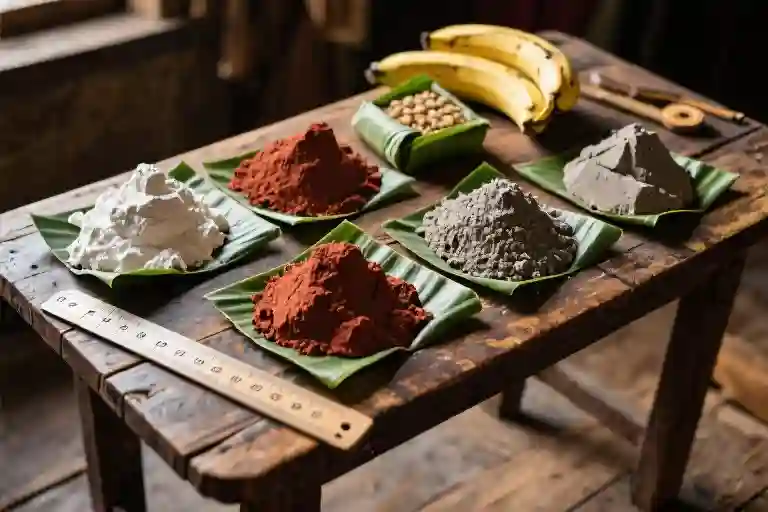The morning ritual was sacred in our household – my father’s hands still smelled of shaving cream when he’d unfold the crisp newspaper, the rustling pages interrupting the hum of our old percolator. I’d lurk nearby like a seagull eyeing chips at the beach, waiting to snatch the lifestyle section before he noticed. Sports pages with their smudged statistics held no appeal, nor the business section’s dry prognostications. What hooked me were those strange little dispatches from the edges of the map, the ones tucked between obituaries and weather reports like hidden coins.
I remember the exact Wednesday it happened – March something, 1994, lower right corner of page 7. A grainy black-and-white photo showed Vietnamese villagers holding what looked like lumpy cookies, except the caption revealed they were eating stones from a nearby quarry. Not grinding them into flour, not using them as famine food, but chewing actual rocks with what appeared to be genuine enjoyment. My ten-year-old brain short-circuited. Forget wondering about nutrition or dental consequences – the only question that mattered was whether those grayish chunks tasted more like the sidewalk chalk I’d accidentally nibbled in kindergarten, or the sea salt crystals we’d lick off pretzels during road trips.
Two decades later, typing “why do people eat stones” into a search engine at 2 AM (because some childhood mysteries never release their grip), I discovered geophagy – the technical term for consuming earth substances. That village wasn’t an anomaly but part of a global pattern stretching from Cameroon’s red clay markets to Georgia’s white kaolin enthusiasts. What began as a kid’s bewildered fascination became a doorway into understanding how hunger, tradition, and biology intertwine in ways that defy our neat categories of ‘food’ and ‘not food.’ Those newspaper crumbs of curiosity led me to a banquet of cultural revelations – though I still can’t tell you if the stones tasted chalky or salty.
The Global Table of Earth
My childhood fascination with that Vietnamese village’s stone-eating practice turned out to be just the tip of the iceberg. Across continents and cultures, people have developed complex relationships with the very ground beneath their feet—not just as something to walk on, but as something to consume.
In Vietnam’s Hà Giang province, the white kaolin clay isn’t merely dirt—it’s both pantry staple and cultural artifact. Pregnant women there have consumed this mineral-rich earth for generations, not as a desperate measure during famine, but as deliberate nutritional supplementation. The practice intertwines with local beliefs about balancing bodily humors, where the coolness of white clay supposedly counteracts pregnancy’s internal heat. What fascinates me isn’t just the biological wisdom (kaolin does provide calcium and iron), but how this knowledge became encoded in tradition long before modern nutrition labels existed.
Crossing over to Cameroon, the red laterite soil tells a different story—one where geology meets economics. In markets from Yaoundé to Bamenda, vendors sell baseball-sized lumps of this iron-rich earth stacked like produce, priced higher by the gram than many conventional foods. The red earth trade supports entire supply chains: miners who carefully select strata free from contaminants, middlewomen who transport it wrapped in banana leaves, and street hawkers who grade their product by texture and mineral content. When anthropologists tracked one batch’s journey, they found some clay changed hands seven times before reaching consumers—a testament to its value as both commodity and cultural currency.
Then there’s the unexpected case of Georgia, USA, where bags of ‘healing clay’ sell at organic markets alongside kale and quinoa. Unlike the Vietnamese and Cameroonian practices rooted in tradition, this modern iteration rebrands soil consumption as a detox ritual among wellness circles. The white kaolin here comes powdered in artisanal packaging, marketed not as folk remedy but as ‘nature’s activated charcoal.’ It reveals how ancient practices get repurposed—sometimes rediscovering legitimate benefits (clay does bind to certain toxins), sometimes veering into pseudoscience.
Three continents, three relationships with earth-as-food: one preserving ancestral knowledge, one sustaining informal economies, one adapting tradition for modern consumerism. Yet beneath these differences lies a shared human truth—we’ve always known the ground gives more than crops. Sometimes, it becomes the meal itself.
The Geology on Our Tongues
That childhood question about how stones might taste lingered longer than I expected. It resurfaced years later when I came across a research paper titled “Geophagy as Adaptive Behavior” in a university library. The scientific explanation finally provided answers my younger self couldn’t find in newspaper margins.
Nature’s Detox Mechanism
Electron microscope images reveal why certain cultures instinctively consumed clay. At 50,000x magnification, montmorillonite clay particles resemble accordion folds with enormous surface area. These microscopic layers act like molecular sponges – a single gram can have a surface area exceeding 800 square meters. When ingested, they bind to plant toxins like glycoalkaloids in potatoes or tannins in unripe fruits, preventing intestinal absorption. Kenyan mothers have known this empirically for generations, giving children white clay during famine seasons when toxic wild tubers become staple foods.
Mineral Bioavailability Paradox
Nutritional analyses of Kenyan clay show iron content comparable to spinach (28mg/100g), but with a crucial difference. While spinach contains iron-inhibiting oxalates, the clay’s iron exists as ferrihydrite nanoparticles. A 2021 Journal of Nutritional Science study demonstrated these particles have 73% higher bioavailability than synthetic iron supplements. This explains why 68% of pregnant women in traditional Maasai communities showed normal hemoglobin levels despite minimal meat consumption – their bodies extracted iron from the very earth beneath their feet.
The Double-Edged Soil
Not all edible earth brings benefits. Testing in India’s Bihar region found some ceremonial eating soils contained lead levels exceeding 300ppm – six times WHO safety limits. This dark side of geophagy emerges when urbanization introduces industrial contaminants to traditional soil sources. Yet even here, cultural wisdom often anticipated modern science: many communities practiced meticulous soil selection, favoring specific clay veins while avoiding reddish soils historically associated with “bad stomach.”
What began as a child’s curiosity about flavors evolved into understanding soil’s dual role – both nourisher and protector. The practice persists not because of primitive ignorance, but through generations observing how certain earths literally sustained life. Perhaps we’ve been asking the wrong question all along. Instead of “Why eat dirt?”, the more revealing inquiry might be “What took us so long to recognize its purpose?”
Cultural Stratigraphy: From Stigma to Superfood
The colonial administrators’ journals from the 1890s make for uncomfortable reading. Pages upon pages of horrified descriptions labeled geophagy as “proof of savage inadequacy”—never mind that their own apothecaries sold terra sigillata, the stamped medicinal clay from Lemnos that Hippocrates himself prescribed. This cognitive dissonance reveals more about power dynamics than nutritional science.
The Colonial Lens
Missionary accounts from Cameroon documented clay consumption with a mixture of fascination and revulsion. One 1904 report describes women eating red earth as “resembling cattle chewing cud,” oblivious to the fact these very soils contained 23mg/kg of bioavailable iron—critical for pregnancy in regions where meat was scarce. The stigma became so entrenched that during the 1930s Belgian Congo, some villages practiced clay eating discreetly at night.
Yet in Europe, the same period saw French spas advertise “detoxifying clay wraps” for wealthy clients. The difference wasn’t in the soil, but in the hands holding it.
Montmorillonite Goes Mainstream
Walk into any Tokyo drugstore today and you’ll find shelves of \”dokudami\” (detox earth) supplements containing the same montmorillonite clay that Vietnamese villagers call “đất sét trắng.” The packaging features cherry blossoms instead of jungle imagery, clinical studies instead of folk wisdom. A 100g jar sells for ¥3,800—roughly 300 times the price of raw clay at a Hà Giang market.
This commercialization raises uneasy questions. When Japanese companies patent processing methods for Amazonian sacred clay, does it constitute biopiracy or cultural validation? The answer likely lies somewhere between, as slippery as wet kaolin.
Microbial Futures
The real paradigm shift came when gastroenterologists noticed something peculiar: children in geophagic communities had 40% fewer cases of pathogenic E. coli infections. Research now suggests certain clays act as microscopic sieves, binding toxins while allowing nutrient absorption. Startups are racing to isolate these properties—one California lab recently filed a patent for “edible mineral matrices for gut microbiome modulation.”
Perhaps the ultimate irony awaits us: future generations might consume probiotic-enhanced soil capsules, blissfully unaware their great-grandmothers dug the same medicine from riverbanks. The earth hasn’t changed. Only our willingness to see its wisdom has.
When Dirt Becomes Dinner
The internet has replaced my father’s crumpled newspaper, but the thrill of discovery remains unchanged. Where I once squinted at smudged newsprint, now I scroll through digital archives—both methods leading to the same startling realization: humans have been eating earth longer than we’ve been baking bread.
This truth sits uncomfortably with our modern obsession with sanitized nutrition. While grocery stores promote ‘clean eating’ with triple-washed greens in vacuum-sealed bags, women in Cameroon’s markets haggle over the iron content of red clay. In Vietnam’s northern mountains, pregnant women still carry lumps of kaolin clay like life-saving medication. The dissonance begs a question: in our quest for dietary purity, have we severed an ancient connection to the very ground beneath us?
Geophagy—the practice of consuming earth—isn’t some primitive hangover. Clinical studies show certain clays can bind to toxins more effectively than activated charcoal. That red soil Kenyan women chew? Laboratory analysis reveals its iron bioavailability rivals pharmaceutical supplements. Our ancestors might not have understood micronutrients, but their cravings mapped to geological resources with startling precision.
Yet cultural bias persists. Western medicine still classifies non-Western earth-eating as ‘pica,’ framing it as a disorder rather than cultural adaptation. Meanwhile, Japanese pharmacies sell montmorillonite clay tablets as gut health supplements, and American wellness influencers hawk ‘detoxifying’ bentonite clay for $40 per jar. The same substance that prompts concern when consumed by an African villager becomes a luxury item when packaged with a minimalist label.
Perhaps the real nutritional deficiency lies in our thinking. Before dismissing geophagy as bizarre, consider that the average American consumes approximately five pounds of food additives annually—substances far more alien to our biology than mineral-rich clay. When Vietnamese elders say “the land knows what we need,” they articulate an intuition modern science is only beginning to quantify through soil microbiome research.
As children, we instinctively understood earth’s appeal—who didn’t taste rain-wet mud at least once? Somewhere between playgrounds and supermarkets, we learned to distrust that impulse. Yet the red clay of Georgia, the white kaolin of Vietnam, and the volcanic ash of Iceland continue whispering that sometimes, the most sophisticated nutrition looks suspiciously like dirt.
(For the experimentally inclined: edible white kaolin clay is available from specialty suppliers, though medical consultation is advised before attempting geophagy. The taste? Exactly as my childhood imagination predicted—like licking a rainy sidewalk, with faint metallic whispers of forgotten minerals.)





